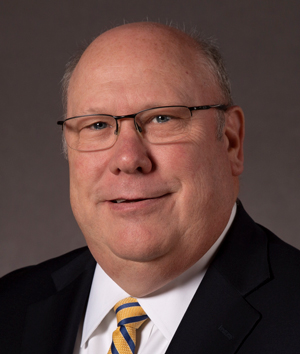 Michael Gray
Michael Gray
System vice president and chief supply chain officer
SSM Health
St. Louis, Missouri
About Michael Gray:
Mike Gray was raised on a small farm in north central Illinois, not far from Toulon. He taught high school students in agriculture and business, and began his healthcare supply chain career in 1989 as a distribution manager for General Medical (now McKesson Medical-Surgical) in Green Bay, Wisconsin. He served for seven years as president and CEO of Mercy Resource Management Inc., a cooperative with responsibilities for supply chain service solutions, among other duties, for 112 hospitals and related facilities. After that, he was chief operating officer of The Resource Group within Ascension, with responsibility for the development, implementation, and management of its strategic direction and User-Directed Strategic Sourcing Model. After running his own consulting firm, he joined SSM Health in February 2018. He received his bachelor’s degree from Western Illinois University and his master’s degree from the University of Illinois.
About SSM Health:
With care delivery sites in Illinois, Missouri, Oklahoma and Wisconsin, SSM Health includes 23 hospitals, more than 290 physician offices and other outpatient and virtual care services, 10 post-acute facilities, comprehensive home care and hospice services, a pharmacy benefit company, a health insurance company and an accountable care organization
Most challenging/rewarding project since joining SSM Health:
- Consolidated the master data management teams and non-pharma buyers under one management structure. “It has allowed us to be consistent and to provide comprehensive quality data into the Enterprise Resource Planning and Electronic Health Records systems,” he says.
- From a contracting perspective, has engaged physician and clinician leaders from across the health system to eliminate unnecessary variation and reduce costs. “Orthopedic, cardiology, general surgery, OB/GYN and other surgeon leaders have been incredibly engaged as we refresh contract strategies in product categories such as total joints, sports medicine, trauma, spine, cardiac rhythm management, instrumentation, preassembled custom kits, etc. Nursing and infection prevention have led in a number of categories, while our pharmacy leaders have been supporting efforts in access, cost and channel management. Food service leaders have also been engaged as we reduce variability, while our laboratory leaders have supported a number of equipment and supply areas to include blood and testing stewardship.”
- Transformed a multiple-purchasing-organization structure within SAP into one systemwide structure, eliminating 124,000 duplicate items. SSM Health had been operating as three different geographies from when SAP was first deployed, says Gray.
- Cleansed the SAP item file to include more nurse-friendly item descriptions, which updates the electronic health record with any applicable changes each evening.
- In the process of centralizing the data management and accuracy assurance of the physician preference cards across the organization.
Looking forward to:
Continuing to work systemwide with physician leaders and others to reduce unnecessary variation in vendors, products, etc. “We should be able to measure which products are used where, and which products lead to favorable outcomes for the majority of patients. It’s exciting getting all these groups together. Rather than calling them ‘value analysis groups,’ I call them ‘solution groups.’”
How are you better at practicing your profession today than you were 5-10 years ago?
“I am more inclusive. The old saying, ‘I know what I’m doing, so let me do it,’ isn’t effective. I’ve never seen an effort where end users, physicians and executive leaders were engaged, and we did not come up with a better result. The input, guidance and insights provided by end users, people in the field and suppliers always make the process better.”
What are the challenges or opportunities facing the next generation of supply chain executives?
“They will have to be operationally sound in order to understand the flow of information, products and cash. Managing ‘technology creep’ is probably the biggest challenge going forward. A number of my peers have told me, ‘We have gone through savings initiatives, but those savings instantly disappear when new, more expensive technologies are introduced and integrated into our systems as the ‘next shiny object.’’”
